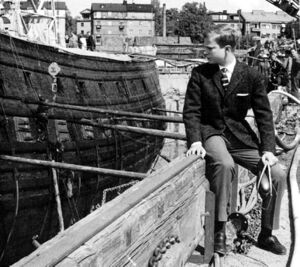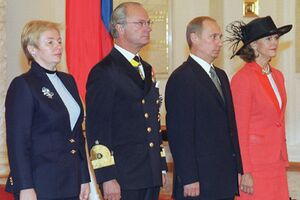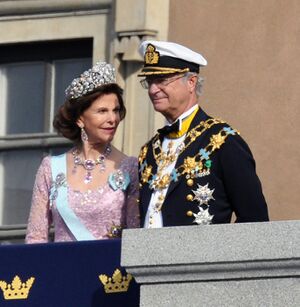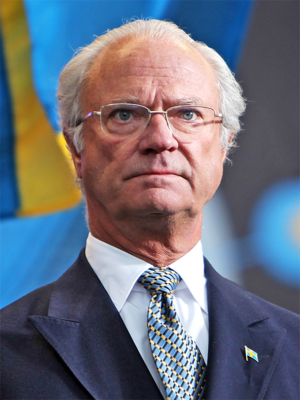Carl XVI Gustaf of Sweden
Script error: No such module "Hatnote".
| ||||||||||||||||||||||||||||||||||||||||
| Template:Swedish Royal Family | ||||||||||||||||||||||||||||||||||||||||
| Template:Infobox Monarch styles | ||||||||||||||||||||||||||||||||||||||||
Carl XVI Gustaf (full name: Carl Gustaf Folke Hubertus, born 30 April 1946) is the reigning King of Sweden since 15 September 1973, succeeding his grandfather King Gustaf VI Adolf. He is the only son of the late Prince Gustaf Adolf, Duke of Västerbotten, who died in 1947, and Princess Sibylla of Saxe-Coburg and Gotha.
Unlike many other European monarchs who have extensive styles, King Carl Gustaf's formal and complete style is simply His Majesty Carl XVI Gustaf, King of Sweden. The King's heir apparent, upon passage on 1 January 1980 of a new law establishing absolute primogeniture (the first such law passed in European history), is Crown Princess Victoria, the eldest child of the King and his wife, Queen Silvia.
Birth and early life
Carl Gustaf was born at then Haga Palace, Solna, in Stockholm County. He was christened at the Royal Chapel on 7 June 1946 by the Archbishop of Uppsala, Erling Eidem. His godparents were Crown Prince Frederick of Denmark, Crown Princess Ingrid of Denmark, Crown Prince Olav of Norway, Crown Princess Juliana of the Netherlands, King Gustaf V of Sweden, Prince Friedrich Josias of Saxe-Coburg and Gotha, Crown Prince Gustaf Adolf of Sweden, Crown Princess Louise of Sweden, Count Folke Bernadotte af Wisborg, and the Countess Maria Bernadotte af Wisborg.
Prince Carl Gustaf was also given the title of the Duke of Jämtland.
His father, Prince Gustaf Adolf, Duke of Västerbotten, was killed in an airplane crash on 26 January 1947, at the Copenhagen Airport.
Youth and education
Prince Carl Gustaf was the youngest of five children and the only son of Sweden's Prince Gustaf Adolf and Princess Sibylla. His father's death had left the nine-month-old Prince second in line for the throne, behind his grandfather, then Crown Prince Gustaf Adolf. When his great-grandfather King Gustaf V died in 1950, the four-year-old Prince became the heir apparent of Sweden.
In a speech[1] in 2005, the King expressed some of his feelings about growing up without having known his father. His sister, Princess Birgitta, elaborated on these feelings in an interview around the same time, commenting that their mother and the strict Swedish royal court of the time did not consider the emotional needs of Prince Gustaf Adolf's children. In that era, she said, tragedy was seldom discussed with children. "Children's questions were met with silence, children's anxiety and fear with the same silence."
As a result, Crown Prince Carl Gustaf was seven years old before he had been told about his father's death. "It was Mother's way of handling the situation, to handle living her life. Of course it was not good for us children. It would have been much better to be able to speak about Father's death", continued Princess Birgitta. She said it had been difficult for the future King to come to grips with not having a father and of not having the same memories of him as his older sisters.

After graduating from high school, the Crown Prince completed two and a half years of education in the Royal Swedish Army, the Royal Swedish Navy, and the Royal Swedish Air Force. He received his commission as an officer in all three services in 1968, and he eventually rose to the rank of captain (in the army and air force) and lieutenant (in the navy), before he ascended to the throne. He has also completed his academic studies in history, sociology, political science, tax law, and economics at Uppsala University and Stockholm University.
To prepare for his role as the Head of State, Crown Prince Carl Gustaf followed a broad program of studies on the court system, social organizations and institutions, trade unions, and employers' associations. In addition, he closely studied the affairs of the Parliament of Sweden, Government, and Ministry for Foreign Affairs. The Crown Prince also spent time at the Swedish Mission to the United Nations and the Swedish International Development Cooperation Agency (SIDA), worked at a bank in London, at the Swedish Embassy in London, at the Swedish Chamber of Commerce in France, and at the Alfa Laval Company factory in France.
King
On 15 September 1973, Carl Gustaf became King of Sweden upon the death of his grandfather, King Gustaf VI Adolf. He was invested as King, at the Hall of State of the Royal Palace of Stockholm on 19 September 1973. King Gustaf VI Adolf was the last who used the style By the Grace of God King of the Swedes, the Goths/Geats and the Wends (Template:Lang-sv; Template:Lang-la). This traditional title had been in use since the establishment of the hereditary monarchy in 1544. Carl XVI Gustaf instead chose the plain and simple title King of Sweden (Template:Lang-sv), thereby ending a tradition centuries old.[2]
Such innovations are reflected in his personal motto, "For Sweden – With the times"[3] (Template:Lang-sv).[4]
In 2005, King Carl Gustav made a personal and passionate speech about the 2004 Indian Ocean tsunami, a disaster which caused the death of over 500 Swedes in that area, in addition to tens of thousands of more people.
Regnal name
In the 16th century, Johannes Magnus construed a mythical line of Swedish kings, beginning with Magog, the son of Japheth, in an attempt to substantiate the antiquity of the Swedish throne. Based on that list, King Charles IX (reigned 1604 to 1611) adopted an exaggerated ordinal much higher than that warranted by any reliable historical accounting. Consequently, previous monarchs named Charles (Karl) have traditionally been numbered by counting backwards from Charles IX, though there only were two before him. Thus the current King of Sweden was proclaimed as Carl XVI Gustaf (sometimes counted in English also as "Charles XVI", though he is never called that) even though he is only the tenth historical Swedish king named Carl (Karl, or Charles).[5]
Official duties

The King's duties are, according to the 1974 Instrument of Government, only of a representative and ceremonial nature. The 1974 document stripped the King of most of his formal political powers while retaining him as head of state, thus codifying actual practices dating from the definitive establishment of parliamentary government in 1917.
He pays State Visits abroad and receives those to Sweden, opens the Annual Session of the Parliament, chairs the Special Council held during a change of Government, holds regular Information Councils with the Prime Minister & the Cabinet, chairs the meetings of the Foreign Affairs Council, and receives and signs Letters of Credence of foreign ambassadors to Sweden and signs those of Sweden to foreign nations. As this type of figurehead, he also voluntarily abstains from voting in Swedish elections.[6]
King Carl Gustav (ceremonially) holds the highest ranks in the three branches of the Swedish Armed Forces; this is due to the fact that he was, as stipulated by the 1809 Instrument of Government in effect at the time of his accession to the throne in 1973, the Commander in Chief of the armed forces of Sweden (§ 14) and therefore he was promoted ex officio from his earlier ranks of captain and lieutenant, to general and admiral. Under the provisions of the Instrument of Government of 1974, which became effective on 1 January 1975, King Carl Gustav no longer holds this constitutionally-mandated position of commander-in-chief, but he kept his ranks à la suite since he no longer has any military command authority, except over his military staff at his court.
Worldwide, Carl XVI Gustaf is probably best known as the presenter of the Nobel Prizes each year. He also hands over the Polar Music Prize. The King holds honorary doctoral degrees from the Swedish University of Agricultural Sciences, the Royal Institute of Technology, the Stockholm School of Economics and from the Åbo Akademi University in Finland.
Personal interests
The King is passionate about the environment, technology, agriculture, trade, and industry.
Like many members of the Royal Family, the King has a keen interest in automobiles. He owns several Porsche 911s — a car model which is said to be a particular favourite of the King — as well as a vintage Volvo PV444, a Ferrari 456M GT, an authentic AC Cobra and other cars.[7] The first pictures taken of him and his future wife were of them sitting in his Porsche 911. In the summer of 2005 he was involved in a traffic accident in Norrköping. The accident was described as a "fender bender", with no serious personal injuries claimed. Nevertheless, the incident caused national headlines.[8]
Scouting
The King is the Honorary Chairman of the World Scout Foundation, and often participates in Scout activities both in Sweden and abroad. He regularly visits World Scout Jamborees, for instance the 1979 Dalajamb World Jamboree International Encampment hosted by Sweden, the 2002 World Jamboree held in Sattahip, Thailand, and the 100th Anniversary of World Scouting 2007 World Jamboree held in Hylands Park, England.[9] He also attended the 1981 National Scout Jamboree in Virginia, United States, and was awarded the Bronze Wolf, the only distinction of the World Organization of the Scout Movement, awarded by the World Scout Committee for exceptional services to world Scouting, in 1982. He also attended the 22nd World Scout Jamboree. He gave a speech on 6 August at the closing ceremony with more than 40,000 people watching. The band Europe also performed for him singing "The Final Countdown".
Biofuels research
The King attended the Sweden-Michigan Clean Energy Summit at the Ritz-Carlton Hotel in Dearborn, Michigan, on 26 September 2008, at the start of a two-day visit to Michigan. He also traveled to Kettering University in Flint, Michigan, for the ceremonial groundbreaking for a biogas plant that will be, when completed, similar to a biogas plant in Linköping, Sweden. On the second day of his visit he toured the test tracks of the Ford Motor Company and General Motors Corporation, then owners of Volvo and Saab respectively.[10]
Marriage and family

The King married Silvia Sommerlath, whose father was German and whose mother was Brazilian, and who had grown up in both countries. They met at the 1972 Summer Olympics in Munich, where she was an interpreter and hostess. The wedding was held on 19 June 1976, at the Stockholm Cathedral, and the ceremony was performed by the Archbishop of Uppsala, Olof Sundby. The wedding was preceded, the evening before, by a Royal Variety Performance, where the Swedish musical group ABBA performed Dancing Queen for the very first time, as a tribute to Sweden's Queen to be.[11][12] The King and his family moved to Drottningholm Palace west of Stockholm in 1980. He and the Queen have maintained their business offices at the Royal Palace of Stockholm.
King Carl Gustav and Queen Silvia have three children:
- Her Royal Highness Crown Princess Victoria Ingrid Alice Désirée, Duchess of Västergötland, born on 14 July 1977. She was married on 19 June 2010, to Daniel Westling, who was born on 15 September 1973, (on the same day that Carl Gustav received the Swedish crown).
- His Royal Highness Prince Carl Philip Edmund Bertil, Duke of Värmland, born on 13 May 1979.
- Her Royal Highness Princess Madeleine Thérèse Amelie Josephine, Duchess of Hälsingland and Gästrikland, born on 10 June 1982.
Prince Carl Philip was born the heir apparent. However, a Constitutional reform, which was already under way at the time of his birth, made his older sister, Victoria, the heiress-apparent and Crown Princess of Sweden on 1 January 1980, according to the principles of absolute primogeniture, which Sweden was the first recognized monarchy to adopt.[13] King Carl Gustaf objected, not to the restored female succession but to the fact that his son lost the position and title of Crown Prince of Sweden which he had had since birth.[14]
Dyslexia
For many years, it was widely reported that King Carl Gustav had dyslexia. Journalists noted that he misspelled his name when signing his accession document, and in 1973, while visiting a copper mine in Falun, he misspelled his name as "Cal Gustf" when signing it on a rock wall. In an interview on Swedish television in 1997, this condition was admitted publicly when his wife addressed the issue. "When he was little, people did not pay attention to the problem," she said. "He didn't get the help he needed." She also noted that the couple's children have "a bit of" dyslexia themselves.
Titles, styles,honours and arms
Title and styles
|
The Regal Assurance taken by His Majesty King Carl XVI Gustaf on 19 September 1973 Administered by Mr. Lennart Geijer, Councillor of State and Head of the Ministry for Justice Unofficial English language translation "We, Carl Gustaf, King of Sweden make known: that as our Supreme God has pleased to call away the formerly mighty, high-born Prince and Lord, Gustaf VI Adolf, King of the Swedes, the Goths and the Wends, and We, according to, and by authority of, the Act of Succession, as established and enacted by the Estates of the Realm on 26 September 1810, following the illustrious Lord, have ascended to the Royal Swedish Throne. Therefore We assure most solemnly and loudly, that We intend to and shall Govern the Realm in accordance with the on 6 June 1809 by the King and the Estates of the Realm, jointly enacted and for observance issued Instrument of Government, literal direction abide, and to the other Fundamental Laws of the Realm, public laws and legal ordinances. We shall also, conform to the before mentioned Instrument of Government and laws, as a resolute King and a caring father for the Swedish people, throughout a legal, just and lenient Reign, seek to by Our utmost ability to advocate the veritable interests and welfare of the Realm and that of each of its inhabitants, all of which We by free will and following mature consideration have decided to do, We thus confirm this by the written signature of Our name, and by a lively oath, that this We shall adhere to and carry out, so truly help me God to life and mind."
|
- 30 April 1946 – 7 June 1946: His Royal Highness Carl Gustaf, Hereditary Prince (sv. Arvprins) of Sweden
- 7 June 1946 – 29 October 1950: His Royal Highness Carl Gustaf, Hereditary Prince of Sweden, Duke of Jämtland
- 29 October 1950 – 15 September 1973: His Royal Highness Carl Gustaf, Crown Prince of Sweden, Duke of Jämtland
- 15 September 1973 – present: His Majesty Carl XVI Gustaf, King of Sweden
Carl XVI Gustaf's current title is King of Sweden with the style His Majesty. He is usually in contemporary Swedish language use and society referred to as simply "the King" (Template:Lang-sv). In formal events and matters of protocol, he is however referred to as "Your Majesty" (Template:Lang-sv) or "His Majesty the King" (Template:Lang-sv).
Arms
On his creation as Duke of Jämtland, Carl XVI Gustaf was granted an achievement of arms which featured the arms of Jämtland in base (these arms can be seen on his stallplate as knight of the Danish Order of the Elephant at Frederiksborg Palace). Since his accession to the throne, he has used the greater coat of arms of Sweden.
| Arms of Carl XVI Gustaf from 1946 to his accession to the throne, as Duke of Jämtland. | |
 |
Arms used since his accession to the throne. |
Swedish appointments and honours
- Template:Country data Sweden Lord and Master (and Knight) of the Order of the Seraphim
- Template:Country data Sweden Lord and Master (and Commander Grand Cross) of the Order of the Polar Star
- Template:Country data Sweden Lord and Master (and Commander Grand Cross) of the Order of the Sword
- Template:Country data Sweden Lord and Master (and Commander Grand Cross) of the Order of Vasa
- Template:Country data Sweden Lord and Master (and Knight) of the Order of Charles XIII
Foreign honours
- Template:Country data Austria: Grand Star of the Decoration of Honour for Services to the Republic of Austria
- Template:Country data Belgium: Grand Cordon of the Order of Leopold
 Brazil: Grand Collar of the Order of the Southern Cross
Brazil: Grand Collar of the Order of the Southern Cross- Template:Flagicon image Commonwealth realms: Recipient of the Royal Victorian Chain
- Template:Country data Denmark: Knight with Collar of the Order of the Elephant
- Template:Country data Denmark: Grand Commander of the Order of the Dannebrog
- Template:Country data England: Stranger Knight of the Order of the Garter (967th member)
- Template:Country data Estonia: Collar of the Order of the Cross of Terra Mariana
- Template:Country data Finland: Grand Cross with Collar of the Order of the White Rose (Photo)
- Template:Country data France: Grand Cross of the Legion of Honour
 Germany: Grand Cross of the Order of Merit of the Federal Republic of Germany
Germany: Grand Cross of the Order of Merit of the Federal Republic of Germany Greece: Grand Cross of the Order of the Redeemer
Greece: Grand Cross of the Order of the Redeemer- Template:Country data Iceland: Grand cross with Collar of the Order of the Falcon
 Japan: Collar of the Order of the Chrysanthemum
Japan: Collar of the Order of the Chrysanthemum- Template:Country data Latvia: Commander Grand Cross with Chain of the Order of Three Stars (1995)
- Template:Country data Lithuania: Grand Cross of the Order of Vytautas the Great
- Template:Country data Luxembourg: Knight of the Order of the Gold Lion of the House of Nassau
- Template:Country data Malaysia: Knight of the Order of the Crown of the Realm [15][16]
- Template:Country data Mexico: Collar of the Order of the Aztec Eagle
- Template:Country data Netherlands: Grand Cross of the Order of the Netherlands Lion
- Template:Country data Netherlands: Grand Cross of the Order of the House of Orange
 Norway: Grand Cross with collar of the Royal Norwegian Order of St. Olav
Norway: Grand Cross with collar of the Royal Norwegian Order of St. Olav- Template:Country data Poland: Grand Cross of the Order of the White Eagle
- Template:Country data Portugal: Grand Collar of the Order of Prince Henry (1987)
- Template:Country data Portugal: Grand Collar of the Order of Saint James of the Sword (2008) [17]
- Template:Country data Romania: Sash Rank of the Star of Romania
- Template:Country data Slovakia : Grand Cross (or 1st Class) of the Order of the White Double Cross (2002)[18]
- Template:Country data Spain: Knight of the Order of the Golden Fleece (1,183rd member)
- Template:Country data Spain: Grand Cross Collar of the Order of Charles III
- Template:Country data Thailand: Knight of the Order of the Rajamitrabhorn
- Template:Country data Thailand: Member of the Order of Ramkeerati
- Template:Country data Ukraine: Member of the Order of Liberty
- Template:Country data Ukraine: The First Class of the Order of Prince Yaroslav the Wise
Honorary military positions
- Template:Country data UK Honorary Admiral, British Royal Navy (Seniority: 25 June 1975)[19]
Patronages
- African Medical and Research Foundation Sweden (AMREF)
- Allmänna Idrottsklubben (AIK)
- Barnens Dags Riksförbund
- Centralföreningen för Idrottens Främjande i Sverige
- Djurgårdens Hembygdsförening
- Friends of the Nationalmuseum
- Friends of the Swedish Museum of Natural History
- Friluftsfrämjandet
- Föreningen Svenska Atheninstitutets Vänner
- Föreningen Konstnärernas Vänner
- Föreningen för Svenskar i Världen
- Gastronomiska Akademien
- Gripsholmsföreningen
- Idrottsföreningen Kamraterna (IFK)
- Kulturen i Lund
- Kungl. Automobil Klubben
- Kungl. Motorbåt Klubben
- Kungl. Svenska Aeroklubben
- Kungl. Svenska Segel Sällskapet
- Riksföreningen mot Cancer
- Royal Physiographic Society in Lund
- Royal Society of Sciences and Letters in Gothenburg
- Royal Society of Sciences in Uppsala
- Royal Swedish Academy
- Royal Swedish Academy of Agriculture and Forestry
- Royal Swedish Academy of Arts
- Royal Swedish Academy of Engineering Sciences
- Royal Swedish Academy of Letters, History and Antiquities
- Royal Swedish Academy of Music
- Royal Swedish Academy of Sciences
- Royal Swedish Society of Naval Sciences
- Royal Swedish Academy of War Sciences
- Save the Visby Ringwall Campaign
- Stiftelsen Det Naturliga Steget
- Stiftelsen Drottningholmsteaterns Vänner
- Stiftelsen Håll Sverige Rent
- Stiftelsen Stockholm Water Foundation
- Stiftelsen Svenska Flaggan
- Stiftelsen Svensk Våtmarksfond
- Stockholms Konserthusstiftelse
- Stockholms Studentsångarförbund
- Svea Orden
- Svenska Arkeologiska Samfundet
- Svenska Blå Stjärnan
- Svenska Djurskyddsföreningen
- Svenska Jägareförbundet
- Svenska Kennelklubben
- Svenska Livräddningssällskapet - Simfrämjandet
- Svenska Motionsdagen (Korpen Svenska Motionsidrottsförbundet)
- Svenska Rominstitutets Vänner
- Svenska Turistföreningen
- Svenska Scoutförbundet och Svenska Scoutrådet
- Svenska Sällskapet för Antropologi och Geografi
- Sverige-Amerika Stiftelsen
- Sveriges Allmänna Konstförening
- Sveriges Hembygdsförbund
- Sveriges Skogsvårdsförbund
- Swedish Bible Society
- Swedish Colonial Society
- Swedish Lions
- Swedish Red Cross
- Swedish Rotary
- Swedish Sports Confederation
- Sångsällskapet Orphei Drängar
- The American-Scandinavian Foundation
- Wilhelm Peterson-Berger Society
- World Scout Foundation
- World Wide Fund for Nature Sweden (WWF)
- Östasiatiska Museets Vänner
Kinship with European counterparts
The King is related to all current European reigning monarchs (at least through John William Friso, Prince of Orange, the most recent common ancestor of today's reigning European royal houses):
Ancestors
| Ancestors of Carl XVI Gustaf of Sweden |
|---|
| Template:Ahnentafel-compact6 |
Patrilineal descent
| Ancestors of Carl XVI Gustaf of Sweden |
|---|
|
Carl Gustaf's patriline is the line from which he is descended father to son. Patrilineal descent is the principle behind membership in royal houses, as it can be traced back through the generations, which means that Carl XVI Gustaf is a member of the House of Bernadotte. Unusual for a European monarch, Carl Gustaf's patriline cannot be traced back further than the beginning of the 17th century.
|
Matrilineal descent
See also
- Swedish Royal Family
- Carl XVI Gustaf's ancestors
- List of state visits made by King Carl XVI Gustaf of Sweden
- List of national leaders
References
- ↑ Template:Sv icon http://wwwb.aftonbladet.se/vss/nyheter/story/0,2789,587642,00.html
- ↑ Template:Sv icon SFS (1973:702)
- ↑ The Roual Family: H.M. King Carl XVI Gustaf
- ↑ Kungafamiljen: H.M. Konung Carl XVI Gustaf
- ↑ Article Karl in Nordisk familjebok
- ↑ Template:Sv iconMonarkens uppgifter.
- ↑ Template:Sv icon http://expressen.se/index.jsp?a=573067
- ↑ Swedish king crashes car, The Local, 25 August 2005.
- ↑ [1] The King of Sweden at the Jamboree
- ↑ Detroit Free Press, 27 September 2008.
- ↑ Retro Romance: Sweden's Dancing Queen Silivia. Retrieved 6 December 2010
- ↑ YouTube video of the performance. Retrieved 6 December 2010
- ↑ SOU 1977:5 Kvinnlig tronföljd, p.16.
- ↑ Aftonbladet 24 November 2003
- ↑ State Visit of Malaysian King in Sweden, 2005, King Carl XVI Gustav with Order's Sash, Photo 1
- ↑ State Visit of Malaysian King in Sweden, 2005, King Carl XVI Gustav with Order's Sash, Photo 2
- ↑ Portuguese Presidency, King Carl XVI receives the Grand Collar of the Order of Saint James of the Sword and Queen Silvia receives the Grand Cross of the Order of Prince Henry.
- ↑ Slovak republic website, State honours : 1st Class received in 2002 (click on "Holders of the Order of the 1st Class White Double Cross" to see the holders' table)
- ↑ Second Supplement to The London Gazette, No. 46627 Monday, 7 July 1975, Retrieved 18 January 2010.
- Template:Sv icon Ordenskalender 1969 & 1975, Riksmarskalksämbetet, Stockholm.
External links
| Wikimedia Commons has media related to: Carl XVI Gustaf of Sweden |
- Ancestry of Queen Silvia of Sweden
- Royal Court of Sweden - Official site
- UNSG Ban Ki-Moon Lays Wreath Honouring Dag Hammarskjöld of 1 October 2009 and UN Secretary-General with King Carl XVI Gustaf of Sweden
| Regnal titles | ||
|---|---|---|
| Preceded by Gustaf VI Adolf |
King of Sweden 1973 – present |
Incumbent Heir: Victoria |
| Preceded by Gustaf Adolf, Duke of Skåne |
Heir to the Swedish throne 1950–1973 |
Succeeded by Bertil, Duke of Halland as heir presumptive |
| Preceded by Gustaf Adolf, Duke of Skåne |
Crown Prince of Sweden 1950–1973 | |
| Preceded by Alexis Broschek |
Line of succession to the British throne | Succeeded by Carl Philip |
| |||||||||||||||||||||||||||||||||||||||||||||||||||||
Template:Monarchs of Sweden Template:Heads of state of the European Union Member states
af:Carl XVI Gustaf van Swede ang:Carl XVI Gustaf Swēona Cyning ab:Карл XVI Густав an:Carlos XVI Gustavo de Suecia zh-min-nan:Carl 16-sè Gustaf be:Карл XVI Густаў be-x-old:Карл XVI Густаў bs:Carl XVI Gustaf, kralj Švedske bg:Карл XVI Густаф ca:Carles XVI Gustau de Suècia et:Carl XVI Gustaf el:Κάρολος ΙΣΤ΄ Γουσταύος της Σουηδίας eu:Karlos XVI.a Gustavo Suediakoa fa:کارل گوستاف شانزدهم gl:Carlos XVI Gustavo ko:칼 16세 구스타프 hr:Carl XVI. Gustaf io:Karl 16ma Gustaf id:Carl XVI Gustaf dari Swedia is:Karl 16. Gústaf he:קרל השישה עשר גוסטב, מלך שבדיה jv:Carl XVI Gustaf dari Swedia ka:კარლ XVI (შვედეთი) sw:Carl XVI Gustaf wa Uswidi la:Carolus XVI Gustavus (rex Sueciae) lv:Kārlis XVI Gustavs lt:Karolis XVI Gustavas mr:कार्ल सोळावा गुस्ताफ, स्वीडन arz:كارل الستاشر جوستاف ملك السويد ms:Carl XVI Gustaf no:Carl XVI Gustav av Sverige nn:Carl XVI Gustaf av Sverige nrm:Charle XVI dé Suède oc:Carles XVI Gustau pms:Carl XVI Gustaf dla Svessia pl:Karol XVI Gustaw ro:Carl XVI Gustaf al Suediei ru:Карл XVI Густав se:Carl XVI Gustaf sco:Carl XVI Gustaf simple:Carl XVI Gustaf of Sweden sk:Karol XVI. Gustáv sr:Карл XVI Густаф th:สมเด็จพระราชาธิบดีคาร์ลที่ 16 กุสตาฟแห่งสวีเดน tr:XVI. Carl Gustaf vi:Carl XVI Gustaf của Thụy Điển yo:Carl 16k Gustaf ilẹ̀ Swídìn zea:Kârel XVI Gustaaf zh:卡尔十六世·古斯塔夫
- Pages with script errors
- Pages with broken file links
- People from Solna Municipality
- Swedish monarchs
- Reigning monarchs
- Swedish generals
- Swedish admirals
- Order of Charles XIII
- Knights of the Elephant
- Protestant monarchs
- Crown Princes of Sweden
- Knights of the Golden Fleece
- Grand Croix of the Légion d'honneur
- Sashes of the Order of the Star of Romania
- Recipients of the Royal Victorian Chain
- Grand Crosses Special Class of the Order of Merit of the Federal Republic of Germany
- Recipients of the Order of the Three Stars, 1st Class with Chain
- Recipients of the Order of the White Eagle (Poland)
- Royal Navy admirals
- Grand Crosses of the Order of the Redeemer
- Knights of the Order of the Rajamitrabhorn
- Recipients of the Collar of the Order of the Cross of Terra Mariana
- Extra Knights Companion of the Garter
- Grand Commanders of the Order of the Dannebrog
- Knights Grand Cross with Collar of the Order of St. Olav
- Grand Crosses of the Order of the House of Orange
- Grand Crosses with Collar of the Order of the Falcon
- Recipients of the Order of the Seraphim
- Commanders Grand Cross of the Order of the Sword
- Commanders Grand Cross of the Order of the Polar Star
- Grand Crosses of the Order of Vasa
- Commanders Grand Cross with Collar of the Order of the White Rose of Finland
- Grand Cordons of the Order of Leopold (Belgium)
- Grand Collars of the Order of the Southern Cross
- Collars of the Order of the Chrysanthemum
- Recipients of the Order of Vytautas the Great
- Knights of the Order of the Gold Lion of the House of Nassau
- Collars of the Order of the Aztec Eagle
- Recipients of the Collar of the Order of the White Star
- Knights Grand Cross of the Order of the Netherlands Lion
- Grand Collars of the Order of Prince Henry
- Grand Collars of the Order of Saint James of the Sword
- Grand Crosses of the Order of the Tower and Sword
- Grand Crosses with Collar of the Order of Charles III
- Grand Crosses of the Order of the White Double Cross
- Recipients of the Order of Liberty (Ukraine)
- Recipients of the Order of Prince Yaroslav the Wise
- Recipients of the Bronze Wolf Award
- Uppsala University alumni
- Current national leaders
- Scouting and Guiding in Sweden
- Swedish monarchs of German descent
- Living people

